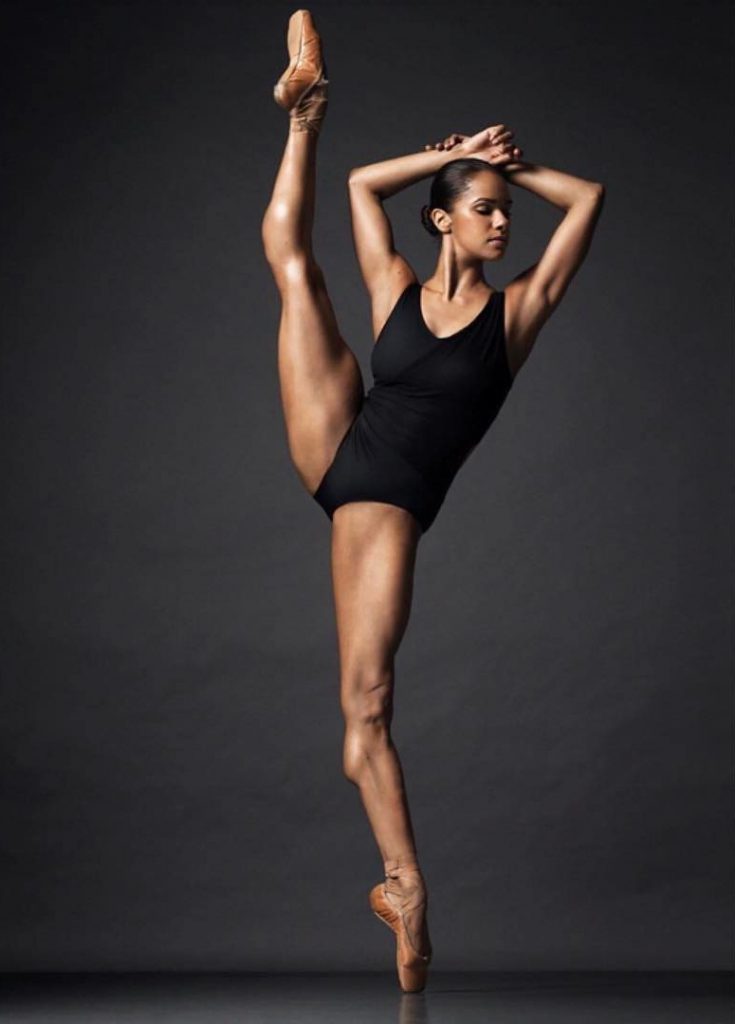“Et un et deux et trois” (and one, and two, and three), are the countless hymns that a typical ballet dancer hears from the rise of dawn to long after sunset. Their long hours in the studio, being constantly on their feet (known as releve), becomes their everyday regime, including exaggerated arm extensions and feet so numb that they do not even feel the blisters from their point shoes; these are examples of the sacrifices and commitments that young ballet dancers experience to make the top one percent that become professionals. An aspiring young African-American woman named Misty Copeland was born to break all barriers in the dance world and change the image of what a ballerina should look like. Misty grew up in a household of five siblings, to a mother of multiple marriages, and to a father who was nearly absent from her life for twenty years; she became American Ballet Theater’s first African-American ballet dancer.1 She is world renowned for her acclaimed performances and the statuesque perfection that has made her an elite dancer. Growing up, she never realized her potential, because of her constant fight for her mother’s attention among her other siblings. Copeland soon realized her passion for dance when she performed dance routines at home to a Mariah Carey chart topper. With no formal ballet or gymnastics experience, she tried out for her middle school drill team, following in her older sister’s footsteps; the elite dance team was recognized for winning countless statewide competitions.2

Even though Misty’s frame was regarded as petite, at thirteen years old Misty was able to use her assertiveness that she gained at home to become captain of the drill team. She was praised for her natural grace and finesse on the dance floor, which later came to the attention of her classically trained coach, Elizabeth Cantine. Off the dance floor, Copeland struggled with the difficulties that her family was enduring. In the year 1994, after her mother’s various friends and boyfriends, her family moved into a small two bedroom Inn in Gardena, California. Along with her brothers and sisters, Misty slept on the floor with only blankets. She regards this memory as, “The hardest time in my childhood,” saying that she made up for the chaos at home by working doubly hard at school.3
Misty’s dance career began at a later age than that of most elite dancers; the average dancer begins training between the ages of four and eight, but her formal training did not begin until age thirteen. Copeland’s middle school drill team coach encouraged her to attend the Boys and Girls Club, where a ballet instructor, Cynthia Bradley, taught free ballet classes once a week. Misty originally declined the offer because her mother did not have a car, and was working twelve to fourteen hours a day, and her oldest sister Erica was working two jobs. But Instructor Bradley began picking Misty up from school. Copeland was able to demonstrate how others’ preconceptions can be disproved with raw talent, “You can start late, look different, be uncertain, and still succeed.”4 Within her brief three months of training with Bradley, Copeland had mastered the French technique of en pointe, which signifies standing on the tip of your toes in ballet shoes, something that takes most ballerinas years to master. As her training became more intensive, Misty began spending most of her hours at the studio, which angered her mother, who told her that she would have to give up ballet. However, Bradley saw a spark of passion in Misty, and offered to host her during her training, as many trainers do for professional athletes. Her mother concluded that it was the best option, considering that their home life was unstable. Copeland explained that the feel of slippers and leotards gave her a sense of confidence and empowerment; she felt like she finally fit in. She had a place to call home and a sport to idolize: “Ballet was so structured. I’d been craving something that could guide me.”5 In the year 1998, at the age of fifteen, she won first prize in the ballet category of the Los Angeles Music Center Spotlight Awards.6

However, that same year a custody battle ensued between the Bradleys and Copeland’s mother. Misty had to return home to her mother, and they had frequent arguments. Her mother had long resented the Bradleys’ influence of homeschooling, Christian religion, and far more personal attention with Misty, and ultimately she decided that Misty would have to cease her continuation with the Bradleys. Misty was distraught with the fear that she would not be able to continue her dance career. The Bradleys then helped Misty to emancipate herself, which was a procedure common among young performers for securing their financial and residential independence. After Misty’s mother received the emancipation documents, she hired famous feminist attorney Gloria Allred and applied a series of restraining orders, which included the Bradleys’ five-year-old son. The order was partly intended to preclude contact between the Bradleys and Misty, but it did not have proper legal basis, since there had been no stalking or harassment.7 The custody controversy was highly publicized in the press: “The attention was devastating,” she says. “I had been so private. It was scarring.”8 After Misty’s mother stated that she would make sure Copeland could dance, both emancipation papers and restraining orders were dropped.
Copeland then began attending San Pedro High School, and continued to study at Lauridsen Ballet Centre in Torrance, California. In 2000, Copeland won another full scholarship, this time to American Ballet Theater’s intensive summer program; and soon after, she became the only African-American woman in a group of eighty dancers. Though she was challenged by her difference, not only her skin color but also her body type, always more full figured than her peers, she nevertheless climbed the ranks by virtue of her exceptional skill.9 In 2007, she became the company’s first African-American female soloist in two decades, with notable performances in The Firebird (2012), in Le Corsaire (2013), and in Swan Lake (2014), to name a few. Copeland’s inspiring story made her a role model and pop icon. She is a New York Times Bestseller in Ballerina Body, a memoir Life in Motion, and Firebird, an inspiring children’s book that shows that through hard work and dedication any young dancer can become a Firebird.10 “I had moments of doubting myself, and wanting to quit, because I didn’t know that there would be a future for an African-American woman to make it to this level. At the same time, it made me so hungry to push through to carry the next generation. So it’s not me up here and I’m constantly saying that it’s everyone that came before me that got me to this position.”11
- Encyclopedia Britannica, 2016, s.v. “Internet,” by Naomi Blumburg. https://www.britannica.com/biography/Misty-Copeland (accessed February 18, 2018). ↵
- Kristen Mascia, “Misty Copeland on Love, Life, and Leaps of Faith,” Elle Magazine, May 29, 2014, 1. ↵
- Kristen Mascia, “Misty Copeland on Love, Life, and Leaps of Faith,” Elle Magazine, May 29, 2014, 1. ↵
- Misty Copeland, Life in Motion (New York: Scholastic Inc, 2017), 262. ↵
- Kristen Mascia, “Misty Copeland on Love, Life, and Leaps of Faith,” Elle Magazine, May 29, 2014, 1. ↵
- Encyclopedia Britannica, 2016, s.v. “Internet,” by Naomi Blumburg. https://www.britannica.com/biography/Misty-Copeland (accessed February 18, 2018). ↵
- Misty Copeland, Life in Motion (New York: Scholastic Inc, 2017), 263. ↵
- Kristen Mascia, “Misty Copeland on Love, Life, and Leaps of Faith,” Elle Magazine, May 29, 2014, 1. ↵
- Encyclopedia Britannica, 2016, s.v. “Internet,” by Naomi Blumburg. https://www.britannica.com/biography/Misty-Copeland (accessed February 18, 2018). ↵
- Macey Morales, “Acclaimed Author, Ballerina Misty Copeland to serve as 2018 National Library Week Honorary Chair,” American Library Association. December 5, 2017, http://www.ala.org/news/press-releases/2017/12/acclaimed-author-ballerina-misty-copeland-serve-2018-national-library-week. (accessed February 18, 2018). ↵
- The Biography.com website, Misty Copeland Biography, https://www.biography.com/people/misty-copeland (accessed February 18, 2018). ↵



87 comments
Constancia Tijerina
When it comes to this type of art, I give full respect to these women and men who are ballerinas; especially more so for Misty Copeland. Even through all her hardship and life complications, she still managed to never let her passion or dreams of becoming the most famous and world known African American ballerina leave her sight. Ever chance and opportunity that was given and fought for, she made sure to in take every moment and opportunity and using her skills and passion to her full potential. Reading this article really gave me so much motivation and open mindedness that anything and everything, if you have passion and dedication, is possible. Great article overall!
Cheyanne Redman
Misty is a perfect example of someone people should look up to. It is interesting to see how she faced so many obstacles in her life from family issues, to rough upbringing, to legal troubles, and still made it as a inspirational figure. Her struggle and success could give motivation to young girls facing the same struggles growing up. Ballet is one of the hardest sports, or arts to perfect and I commend her for being so talented at such a young age. This article was a really interesting read.
Tyler Thompson
This was an amazing article that shows that success comes to those who work hard enough. Misty faced through many challenges such as starting at a typically young age, and not to mention personal problems with her mother. The author did an amazing job with showing how Misty conquered all of her problems to become as successful as she is today.
Miranda Alamilla
I didn’t realize who I was reading about until I got more into the article. I’m not super huge into ballet, even though I used to dance it when I was younger, but I didn’t realize that it’s very hard to start ballet at an older age because of bone development. Misty Copeland truly did the unthinkable; starting ballet at age 14 and coming from a harsh background, she overcame it all and became a true success story.
Jose Figueroa
This article was very inspirational in that she did not let her surroundings stop her from following her dreams. Although she was from a rough place, had a bad family situation and even legal issues she still came out on top. Ballet, is an extremely intensive sport and is widely known to be difficult. With the talent she displayed at 13, I am not surprised she made it that far with her career.
Caroline Bush
This was a great article about to really interesting topic. I have to admit that before reading this article I didn’t know much about Misty Copeland but after reading about her life I have a new appreciation for her struggle and success. Its really amazing how much adversity Misty had to overcome just to participate in her passion but through it all she overcame and succeeded. Its inspiring to see where Misty started to where she ended up, having to lead role in Swan lake and other major plays is nothing to scoff at. Overall this was a very interesting article that kept me engaged the whole way though.
Erin Vento
Ballerinas are definitely some of the strongest humans there can be, and part of what makes what Misty did so amazing (other than the traumatic family experiences) is that she started when she was fourteen. Usually people start extremely young because they need their bones to grow differently and be strong by a certain age. She really is a role model for kids and people who feel like they have something to escape from or feel like they started late.
Samuel Stallcup
My sister has been a dancer since elementary school, and it’s remarkable what she is able to do when she dances. This story was quite interesting too because it is always difficult to create a career out of fine arts. This one is especially interesting considering her family conditions and her race. This article was well-written and the details were plentiful.
Fumei P.
This was such a power article. Even though this was only a sliver of her life, as I was reading I could feel all the tension and emotions that she was might’ve been feeling. It’s just an awful feeling to give up your dream, and for her so prematurely. She stayed dedicated, and she seemed willing to sacrifice her relationship with her family to get her there. Taking the steps towards emancipation and all the drama that ensured between the Bradley’s and her mother seemed really hard to deal with. I’m so impressed with her ability to overcome the hardships in her life for her to get to where she is now.
Hannah Wilson
This was a great article because it goes into good detail about Misty’s life and everything she went through that got her to the level she is at. I can not imagine having to fight against your own family to participate in a sport you love. The Bradley’s interest in heling Misty succeed is admiring, and Copeland sees that without people like the Bradley’s she would not have gotten that far on her own. Great job.